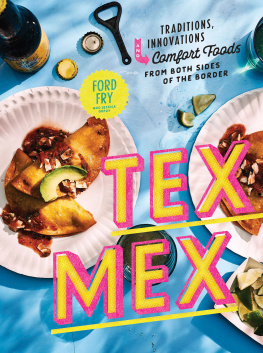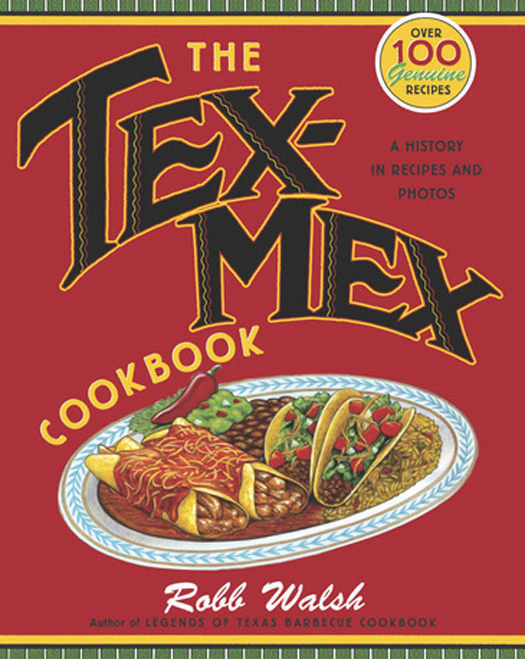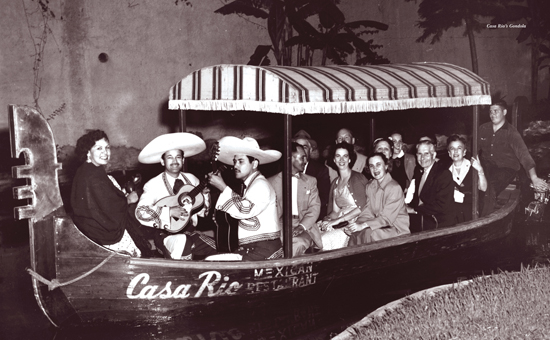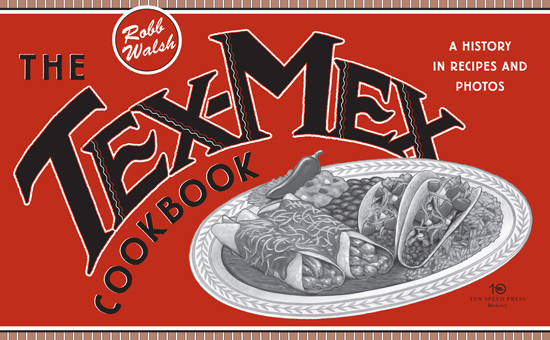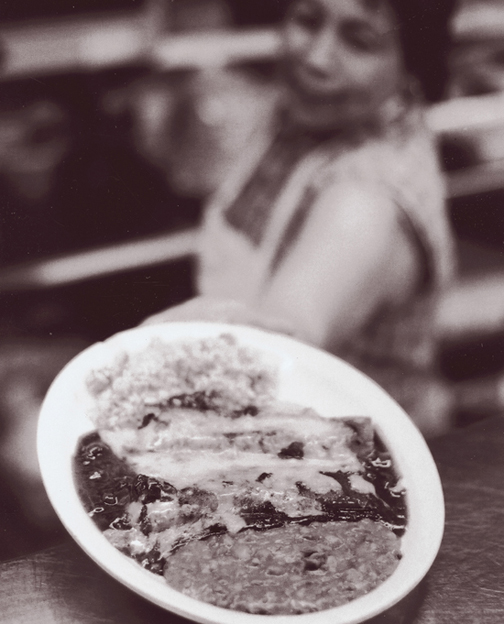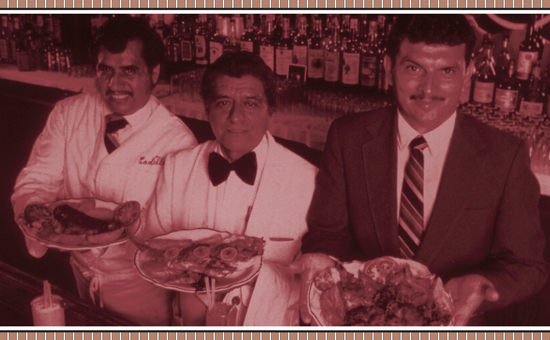Copyright 2004 by Robb Walsh.
All rights reserved. Published in the United States by Ten Speed Press, an imprint of the Crown Publishing Group, a division of Random House, Inc., New York.
www.crownpublishing.com
www.tenspeed.com
Ten Speed Press and the Ten Speed Press colophon are registered trademarks of Random House, Inc.
Originally published in the United States by Broadway Books, New York, in 2004.
Library of Congress Cataloging-in-Publication Data Walsh, Robb, 1952
The Tex-Mex cookbook: a history in recipes and photos / Robb Walsh.1st. ed.
p. cm.
1. Mexican American cookery. 2. Mexican American cookeryHistory.
3. Cookery, AmericanSouthwestern style. I. Title.
TX715.2.S69W36 2004
641.59268720764dc22
2003063673
ISBN 978-0-7679-1488-8
Ebook ISBN 978-1-60774-770-3
v3.1
D EDICATED WITH LOVE TO MY MOTHER ,
M ARY A NN W ALSH
M EXICANS IN S AN A NTONIO , T EXAS , 1887
The back of this souvenir card reads, in part:
A larger percentage of our citizens are Mexicans. They are found in all parts of the city, in all occupations, holding official positions and making good citizens generally. They are good horseman, good traders, and some of them are very handsome Their chief diet is tamales, torties, chilli con carne and enchilades, washed down with black coffee In cooking Mexican dishes, and serving them up hot in the open air, loading a half a cord of wood onto a wagon causing it to seem like a cord and a half, in selling Mexican candy, birds, and fruit on the street, in begging from house to house on Saturday and attending church on Sunday they have few equals and no superiors .
P REVIOUS B OOKS BY R OBB W ALSH
Are You Really Going to Eat That?
Legends of Texas Barbecue Cookbook
A Cowboy in the Kitchen (with Grady Spears)
Nuevo Tex-Mex (with David Garrido)
A CKNOWLEDGMENTS
T HANKS, FIRST AND FOREMOST, TO THE pioneers of Tex-Mex and their descendants who shared the stories, family photographs, and recipes that appear in this book.
Thanks to Rebecca Staffel of the Doe Coover Agency and Jennifer Josephy of Broadway Books for making it all possible. Thanks to Lisa Gray and Lauren Kern for their thoughtful editing. And thanks to Erin Mayes and DJ Stout at Pentagram Design, Austin, for working overtime on design and graphics.
Many thanks to Jay P. Francis for his tireless recipe testing and retesting and his perfect Tex-Mex taste.
Thanks to archivist Tom Shelton at the University of Texas at San Antonios Institute of Texan Cultures for his many historical insights. And to Rayna Green, curator of Julia Childs Kitchen at the Smithsonian Institutes National Museum of American History for helping to bring the heros of Tex-Mex into the national spotlight.
Thanks to the Houston Press and New Times Corporation for permission to borrow freely from my previously published articles.
Thanks for the advice and suggestions of Latin American scholar Justin Wartell at Indiana University, and of librarian Adan Benavides Jr. at the Benson Latin American Collection at the University of Texas at Austin. Special thanks to Texas-Mexican Railway historian Arturo Dominguez for his research; to Marfa historian Cecilia Thompson for all her help; to Mexican-American historian Thomas Kreneck at Texas A&M, Corpus Christi, for explaining the Mexican-American generation; to John T. Edge of the Southern Foodways Alliance at Ole Miss for his Southern tamale tales; and to historian and Mexican food authority Jeffrey Pilcher for his comments and advice on the history of Mexican and Tex-Mex cuisine. Thanks to Eddie Wilson for remembering the birth of hippy Tex-Mex. Thanks also to my fellow Tex-Mex journalists Ron Bechtol and John Morthland for their stories. And many thanks to journalist, musicologist, and all around good guy Joe Nick Patoski for his Tex-Mex music article and bar-hopping advice.
And thanks to my darling Kelly Klaasmeyer and my daughter, Julia Walsh, for eating nothing but Tex-Mex for so long.
An order of cheese enchiladas at Browns Mexican Foods in San Antonio
C ONTENTS
Dinner offerings at the original Cadillac Bar in Nuevo Laredo
I NTRODUCTION
TEX-MEX: THAT LOVABLE UGLY DUCKLING
T EX-MEX IS THE UGLY DUCKLING OF AMERICAN regional cuisines. Since it was called Mexican food for most of its history, nobody even thought of it as American until about thirty years ago. That was when the first authoritative Mexican cookbook in the United States, Diana Kennedys The Cuisines of Mexico , was published.
Kennedy trashed the mixed plates in so-called Mexican restaurants north of the border and encouraged readers to raise their standards. The English-born Kennedy was the wife of the late Paul Kennedy, a New York Times correspondent posted in Mexico City. She had spent little time in the United States at the time of the books publication in 1972 and evidently wasnt familiar with the Tejano culture.
Hugely popular in the United States, The Cuisines of Mexico was a breakthrough cookbook, one that could have been written only by a non-Mexican. It unified Mexican cooking by transcending Mexicos nasty class divisions and treating the food of the poor with the same respect as that of the upper classes. But while admirably egalitarian in her attitude toward the food of Mexicans, Kennedy lambasted the food of Texas-Mexicans.
In a later book, The Art of Mexican Cooking , Kennedy wrote, Far too many people outside Mexico still think of them [Mexican foods] as an overly large platter of mixed messes, smothered with a shrill tomato sauce, sour cream, and grated yellow cheese preceded by a dish of mouth-searing sauce and greasy deep-fried chips. Although these do represent some of the basic foods of Mexicoin name onlythey have been brought down to their lowest common denominator north of the border, on a par with the chop suey and chow mein of Chinese restaurants twenty years ago.
Tex-Mex entered the lexicon of the food world within a year of The Cuisines of Mexico s publication. The first time it was used in print in relation to food, according to the Oxford English Dictionary , was in this 1973 quote from the Mexico City News , an English-language newspaper: It is a mistake to come to Mexico and not try the local cuisine. It is not the Tex-Mex cooking one is used to getting in the United States.
D EFINING T EX -M EX
Oxford English Dictionary: Designating the Texan variety of something Mexican. First use in print , Time magazine, 1941 Tex-Mex Spanish, that half-English half-Spanish patois of the border








